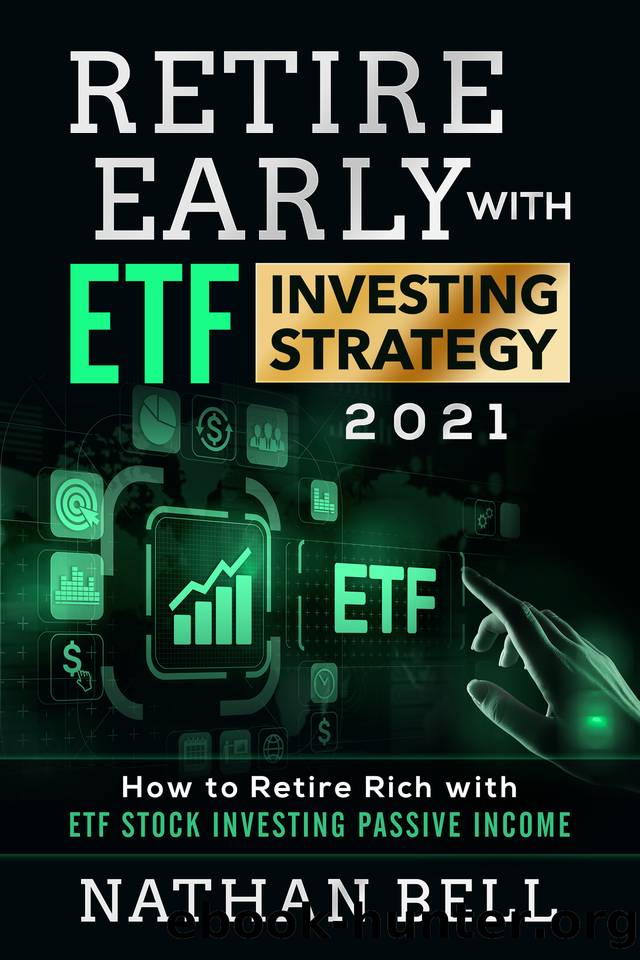Retire Early with ETF Investing Strategy 2021: How to Retire Rich with ETF Stock Investing Passive Income by Bell Nathan

Author:Bell, Nathan [Bell, Nathan]
Language: eng
Format: epub
Published: 2020-09-25T00:00:00+00:00
ETF Share Creation and Redemption
The production and redemption process that sets ETFs aside from all other shared funds starts when a financial investment company sponsor a new fund. The firm records the fund's financial investment purpose, and then it sends a detailed announcing to the SEC for approval. The declaring consists of lawful info regarding the fund, including charges, objectives, threats, symbols, and how it is responsible. That information is ultimately used in the ETF's Prospectus and Statement of Additional Information. Amongst many other items, it reveals how much shareholders will spend on financial investment administration and management expenses.
ETFs track securities indexes, the only exemption being proactively handled ETFs that are forthcoming. A lot of ETF firms certify their indexes from an outside supplier such as S&P, Frank Russell & Company, Dow Jones, and Morgan Stanley Capital International. Along with those heavyweights, loads of smaller sized index suppliers produce and track specific niche indexes. An index can also be one product, such as the price of one ounce of gold or a barrel of oil.
A valuable index for benchmarking has precise treatments for determining index components and the weighting of those components. The method for taking care of an index has to be constant, and the prices of the index must be disseminated in good time. The index supplier generates income by billing licensing costs to fund firms that produce ETFs. Licensing prices become part of the value of an ETF, but the real quantity paid to accredit an index is not revealed. The charge is typically based on a percent of properties in an ETF. S&P may charge 0.02 percent for the licensing rights to the S&P 500 while a niche index such as Intellidex may bill 0.08 percent.
One way some ETF firms lower costs is to develop their indexes, thus maintaining the licensing fee that would need to be paid to the third party. ETF, which adds value back in. WisdomTree Investments, Inc. formed its reward and revenues indexes that their ETFs are benchmarked to. The company worked with the Bank of New York to manage the WisdomTree ETFs to satisfy SEC demands.
Those stocks can be lent to APs during the ETF development process; that financing process makes the investment company a little passion cost for the period of the loan.
A small but essential gamer in ETF administration is the custodial financial institution. A financial institution physically holds securities for a fund. It is the actual entity that refines and accounts for each security's reoccurring. The financial institution commonly makes a small fee based on the possessions in the fund.
The next team to be entailed in ETF share creation and redemption are the most important. They are the authorized participants. APâs are usually referred to as market makers or experts. A new fund signs individual arrangements with several independent AP companies.
When new ETF shares are created, these middlemen either buy or obtain the suitable basket of stocks and trade them with the ETF fund manager for those freshly created ETF shares.
Download
This site does not store any files on its server. We only index and link to content provided by other sites. Please contact the content providers to delete copyright contents if any and email us, we'll remove relevant links or contents immediately.
| Analysis & Strategy | Bonds |
| Commodities | Derivatives |
| Futures | Introduction |
| Mutual Funds | Online Trading |
| Options | Portfolio Management |
| Real Estate | Stocks |
Rich Dad Poor Dad by Robert T. Kiyosaki(6398)
Pioneering Portfolio Management by David F. Swensen(6226)
How To Win Friends and Influence People by Dale Carnegie(4441)
The Money Culture by Michael Lewis(4073)
The Dhandho Investor by Mohnish Pabrai(3698)
The Wisdom of Finance by Mihir Desai(3649)
Liar's Poker by Michael Lewis(3367)
Fooled by Randomness: The Hidden Role of Chance in Life and in the Markets by Nassim Nicholas Taleb(3043)
The ONE Thing by Gary Keller(3007)
The Intelligent Investor by Benjamin Graham Jason Zweig(2995)
Mastering Bitcoin: Programming the Open Blockchain by Andreas M. Antonopoulos(2980)
How to Day Trade for a Living: Tools, Tactics, Money Management, Discipline and Trading Psychology by Andrew Aziz(2909)
Rich Dad Poor Dad: What The Rich Teach Their Kids About Money - That The Poor And Middle Class Do Not! by Robert T. Kiyosaki(2907)
Investing For Dummies by Eric Tyson(2892)
How to Win Friends and Influence People by Dale Carnegie(2860)
Market Wizards by Jack D. Schwager(2643)
Zero Hour by Harry S. Dent Jr. & Andrew Pancholi(2614)
How to Pay Zero Taxes, 2018 by Jeff A. Schnepper(2591)
The Psychology of Money by Morgan Housel(2590)
